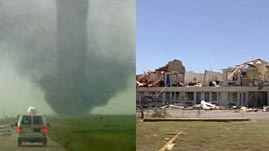Teachers' Domain - Digital Media for the Classroom and Professional Development
User: Preview

Source: Produced for Teachers' Domain
These video segments adapted from NOVA contains drive-by footage of an Oklahoma town's business and residential districts that were ravaged by a passing tornado. The range of damage that tornadoes can cause is evident, as some buildings and houses have been completely destroyed, while others have escaped with little or no damage whatsoever. Additional footage of a tornado in motion illustrates the unpredictable nature of tornadoes, which can appear without warning out of thunderclouds and disappear in moments.
A tornado, from the Latin word tornare (to turn), is a spinning column of air with high wind speeds and low central pressure. It starts as a funnel cloud that pokes through the bottom of a dense thundercloud. When this funnel cloud makes contact with Earth's surface, it becomes a tornado.
About 800 tornadoes, or three-quarters of the world's total, occur each year in the U.S. Many of these touch down in a region called "Tornado Alley," which extends from northern Texas through Oklahoma, Kansas, and Missouri. Each year, tornadoes typically kill 60 Americans, injure another 1,500, and cause more than $400 million in damage, about one-tenth as much as hurricanes cause. Despite being short-lived -- tornadoes last for minutes as opposed to hours -- they are powerful because they concentrate huge amounts of energy into narrow columns of air. Tornadoes vary in size as well as intensity, with only about one percent ever reaching the most violent categories on the Fujita scale, the gauge most commonly used to rate tornado intensity.
The damage tornadoes leave in their wake can be breathtaking and devastating. Their whirling winds can uproot trees, throw vehicles hundreds of feet in the air, and sweep blocks of houses from their foundations. They can inflict total devastation across a wide swath of land or, remarkably, destroy one building and leave others on either side largely untouched. Scientists estimate that the most powerful of these terrifying storms produce winds topping 500 kilometers per hour (310 miles per hour). Meter for meter, they're considered the most violent of all weather events.
The extent and variability of tornado damage on commercial and residential areas depend on several factors, including differences in building construction, wind speed, wind direction, and wind duration. We are not likely to develop a way to stop a tornado, but we can minimize loss of life and property damage by improving early warning systems and designing property to better withstand a tornado's force. In recent years, new technologies have improved the accuracy with which weather forecasters can make predictions, and continuing research has helped engineers understand how tornadoes interact with structures, enabling them to design or modify buildings accordingly to minimize damage.
 Loading Standards
Loading Standards Teachers' Domain is proud to be a Pathways portal to the National Science Digital Library.
Teachers' Domain is proud to be a Pathways portal to the National Science Digital Library.
